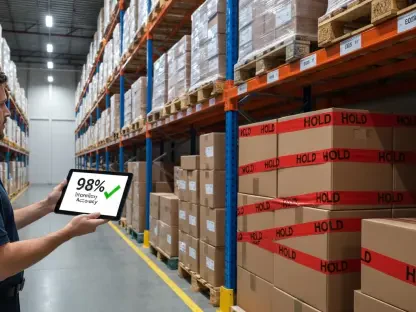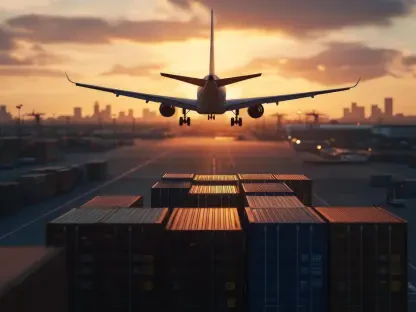Introduction to a Shifting Trade Landscape
The landscape of US imports is undergoing a seismic shift, with retailers grappling to keep pace in a world where international trade accounts for a significant portion of their supply chains, and as global trade barriers tighten and regulatory frameworks evolve, businesses face mounting pressures to deliver goods swiftly while managing spiraling costs. A staggering volume of goods crosses US borders annually, yet the complexities of customs clearance and compliance threaten to disrupt this flow, especially for high-volume retailers during peak seasons. This report delves into how DHL Global Forwarding’s innovative consolidated clearance service offers a lifeline to importers navigating these turbulent waters.
Unpacking the US Import Environment
The US import sector remains a cornerstone of the national economy, with international trade fueling retail growth and consumer access to diverse products. Retailers rely heavily on seamless cross-border operations to stock shelves and meet demand, particularly during high-stakes periods like the holiday season. However, fluctuating global trade patterns and escalating geopolitical tensions have introduced new layers of uncertainty, impacting supply chain reliability and cost structures.
Key players like DHL Global Forwarding play a pivotal role in stabilizing this ecosystem by providing logistics solutions tailored to complex trade dynamics. The influence of tariff policies, currently at their most restrictive levels in nearly a century, further complicates the landscape. Regulatory shifts demand agility from importers, who must adapt to stringent compliance requirements while maintaining operational efficiency in an increasingly competitive market.
DHL’s Consolidated Clearance Service: Revolutionizing Imports
Tackling Core Import Obstacles
US importers face a barrage of challenges, from soaring operational costs to prolonged customs clearance times that delay product availability. The recent termination of the ‘de minimis’ exemption, which once allowed duty- and tax-free entry for shipments under $800, has intensified these issues, forcing businesses to navigate more rigorous entry processes. Compliance risks have surged as a result, with retailers struggling to align with updated regulations without sacrificing speed or profitability.
DHL’s consolidated clearance service addresses these pain points head-on by streamlining the customs process. By combining multiple shipments into a single entry, the service reduces the administrative burden and minimizes delays at the border. This approach not only simplifies documentation but also mitigates the risk of errors, offering a practical solution for businesses overwhelmed by the intricacies of modern trade rules.
Advantages for Retail Giants
For retailers, the benefits of DHL’s new service are manifold, particularly in terms of cost efficiency and time savings. By consolidating shipments, businesses can significantly cut down on customs-related expenses, a critical advantage when profit margins are under pressure. Faster clearance times also ensure products reach shelves sooner, a game-changer during peak retail events like Black Friday when every hour counts.
Insights from DHL leadership underscore the intense demands placed on retailers to balance speed, cost, and compliance. Greg Nichols, Senior Vice President of Global Customs at DHL Global Forwarding, has emphasized that the service alleviates operational stress by providing a reliable framework for customs processing. This support is especially vital during high-demand seasons, enabling retailers to focus on customer satisfaction rather than logistical hurdles.
Regulatory Shifts Reshaping Import Practices
The termination of the ‘de minimis’ exemption on August 29 marked a turning point for US importers, ending a policy that facilitated duty- and tax-free clearance for low-value shipments. This change has ushered in a new era of formal and informal entry processes, requiring businesses to allocate more resources to customs compliance. The shift disproportionately affects high-volume retailers, who must now manage a greater volume of paperwork and oversight.
DHL’s consolidated clearance service offers a strategic adaptation to these stricter requirements by simplifying the entry process. By merging multiple shipments into one streamlined entry, the service reduces the complexity of compliance, allowing retailers to navigate regulatory demands with greater ease. This capability is crucial for maintaining supply chain continuity in the face of evolving trade policies.
Confronting Tariff Burdens and Trade Instability
Current US tariff levels, reportedly the highest since the 1930s, pose a formidable challenge for importers already contending with thin margins and volatile markets. These elevated tariffs increase the cost of goods, forcing retailers to either absorb expenses or pass them on to consumers, both of which risk eroding competitiveness. The financial strain is compounded by unpredictable trade policies that disrupt long-term planning.
Global trade volatility further exacerbates these issues, with shifting alliances and supply chain disruptions creating an unstable environment for cross-border commerce. DHL’s service counters this uncertainty by offering a predictable and efficient customs clearance process. This reliability enables retailers to plan with confidence, mitigating the impact of external pressures on their operations.
Emerging Trends in Cross-Border E-Commerce and Customs Innovation
The cross-border e-commerce market is poised for explosive growth, with projections estimating a value of $4.81 trillion by 2032. This expansion is driven by rising consumer demand for international products and seamless purchasing experiences. However, as online shopping transcends borders, the expectations for quick delivery and transparent pricing continue to heighten, placing additional pressure on logistics providers.
Consumer frustration with unexpected customs charges and cumbersome return processes remains a significant barrier, often leading to abandoned purchases. DHL’s consolidated clearance service aligns with the need for efficient solutions by minimizing delays and hidden costs at the border. This alignment not only enhances the customer experience but also supports retailers in capturing a larger share of the burgeoning e-commerce market.
Reflecting on DHL’s Contribution to Import Triumphs
Looking back, DHL’s consolidated clearance service emerged as a vital tool for US importers, adeptly addressing the multifaceted challenges of regulatory compliance, escalating costs, and prolonged clearance times. The initiative provided a beacon of efficiency for retailers navigating the aftermath of the ‘de minimis’ exemption termination and historically high tariffs. It stood out as a testament to the power of innovative logistics in sustaining business operations amidst trade volatility.
For the future, stakeholders are encouraged to leverage such solutions to build resilient supply chains capable of withstanding regulatory shifts and market fluctuations. Retailers need to prioritize partnerships with logistics experts like DHL to stay ahead of evolving consumer expectations and customs complexities. Embracing scalable clearance strategies becomes essential to ensure competitiveness, particularly during peak seasons when operational agility defines success in the global trade arena.









